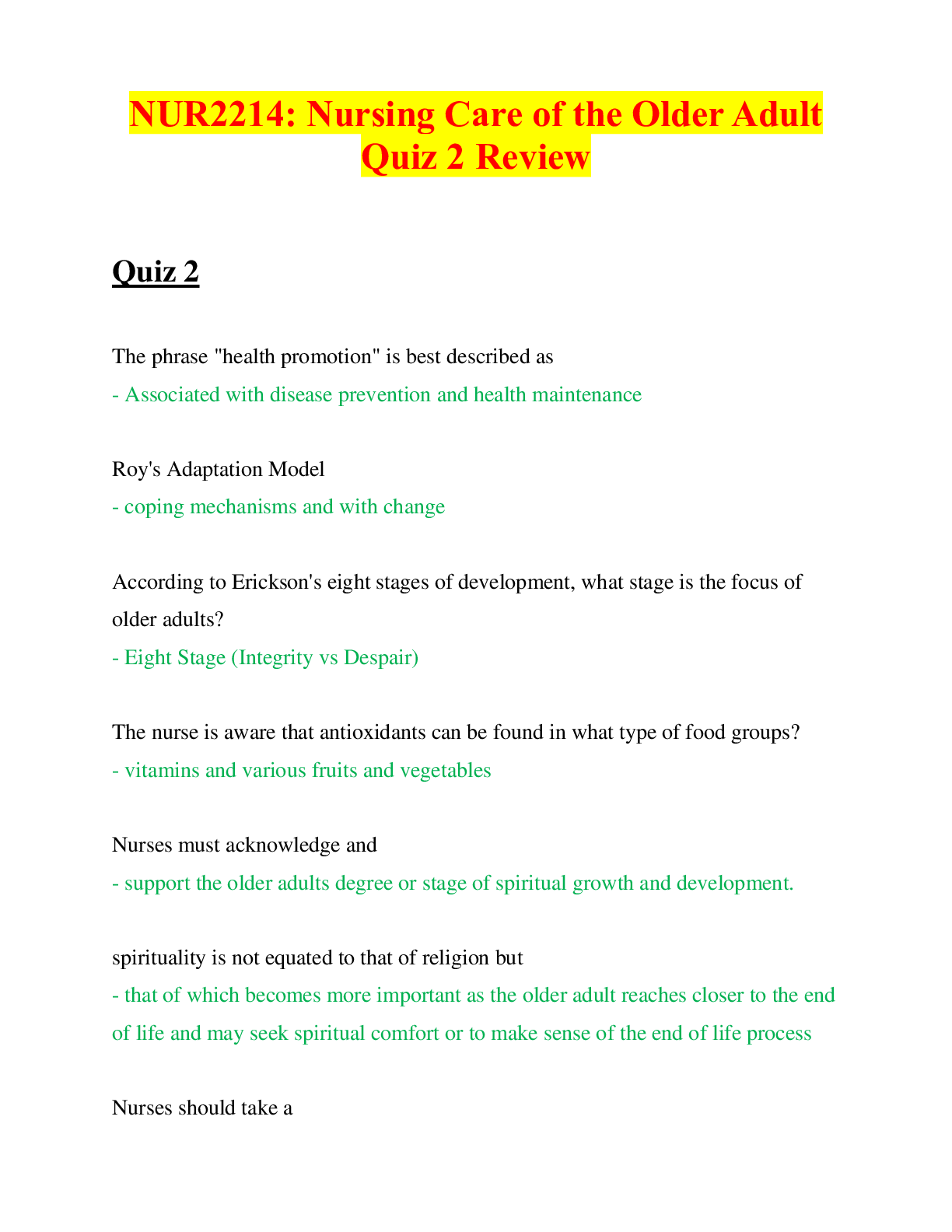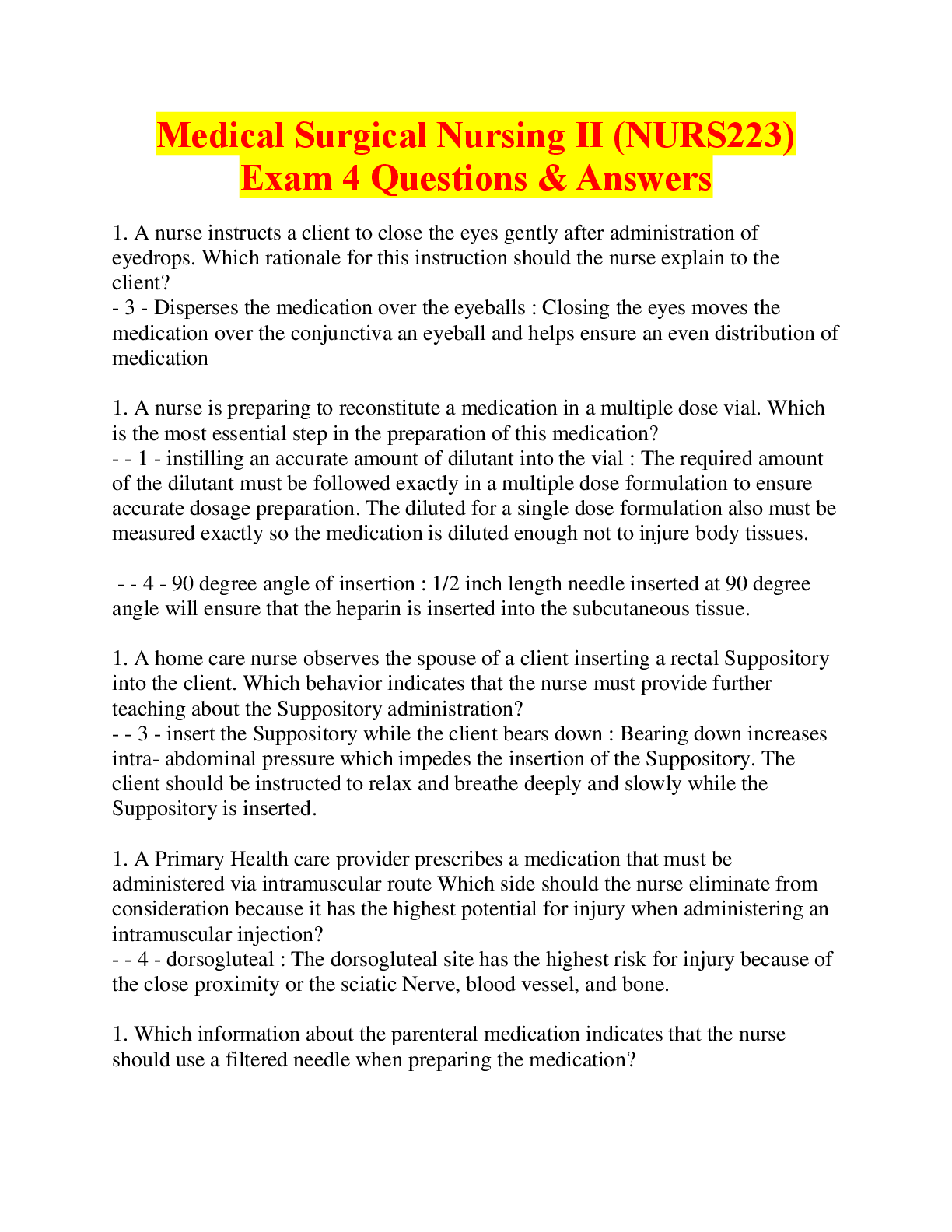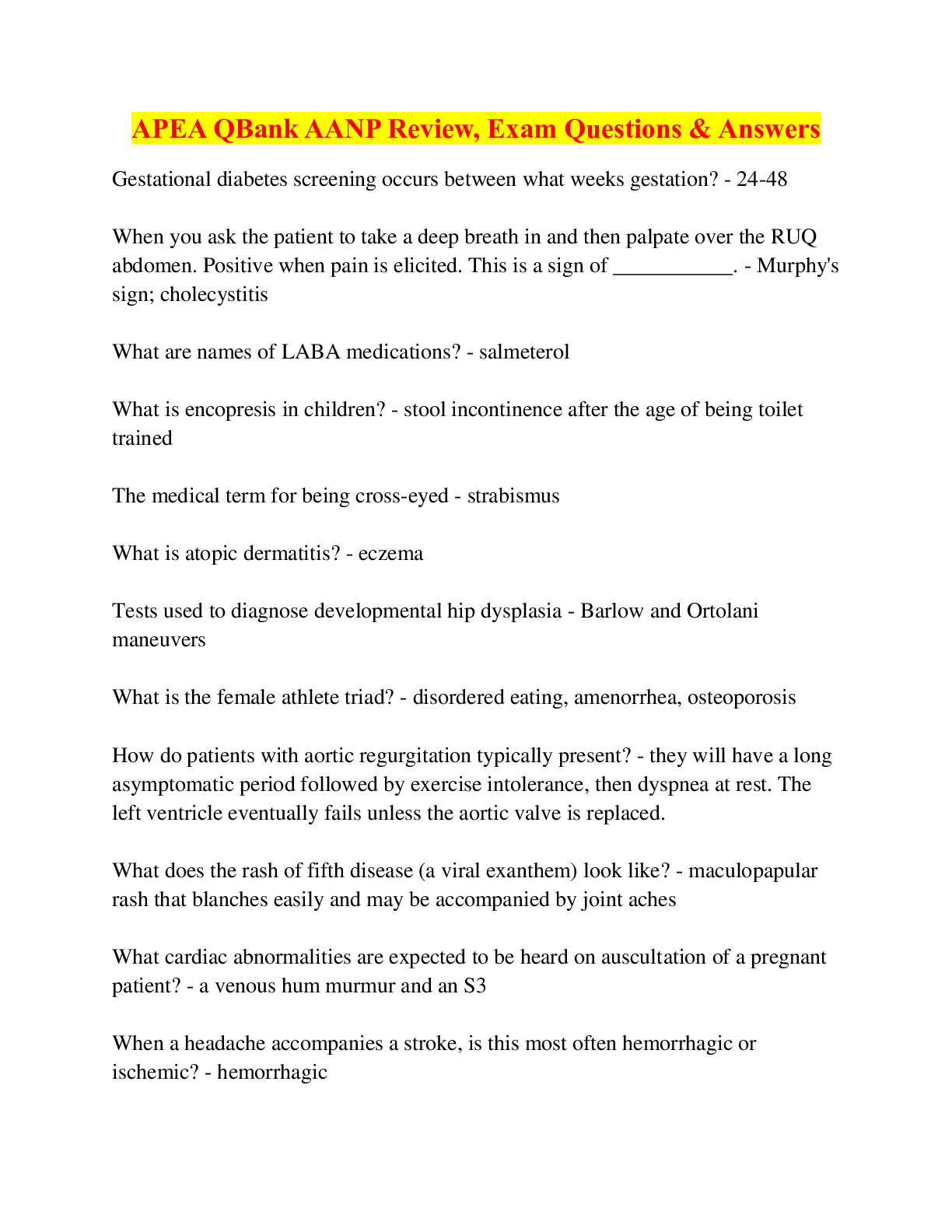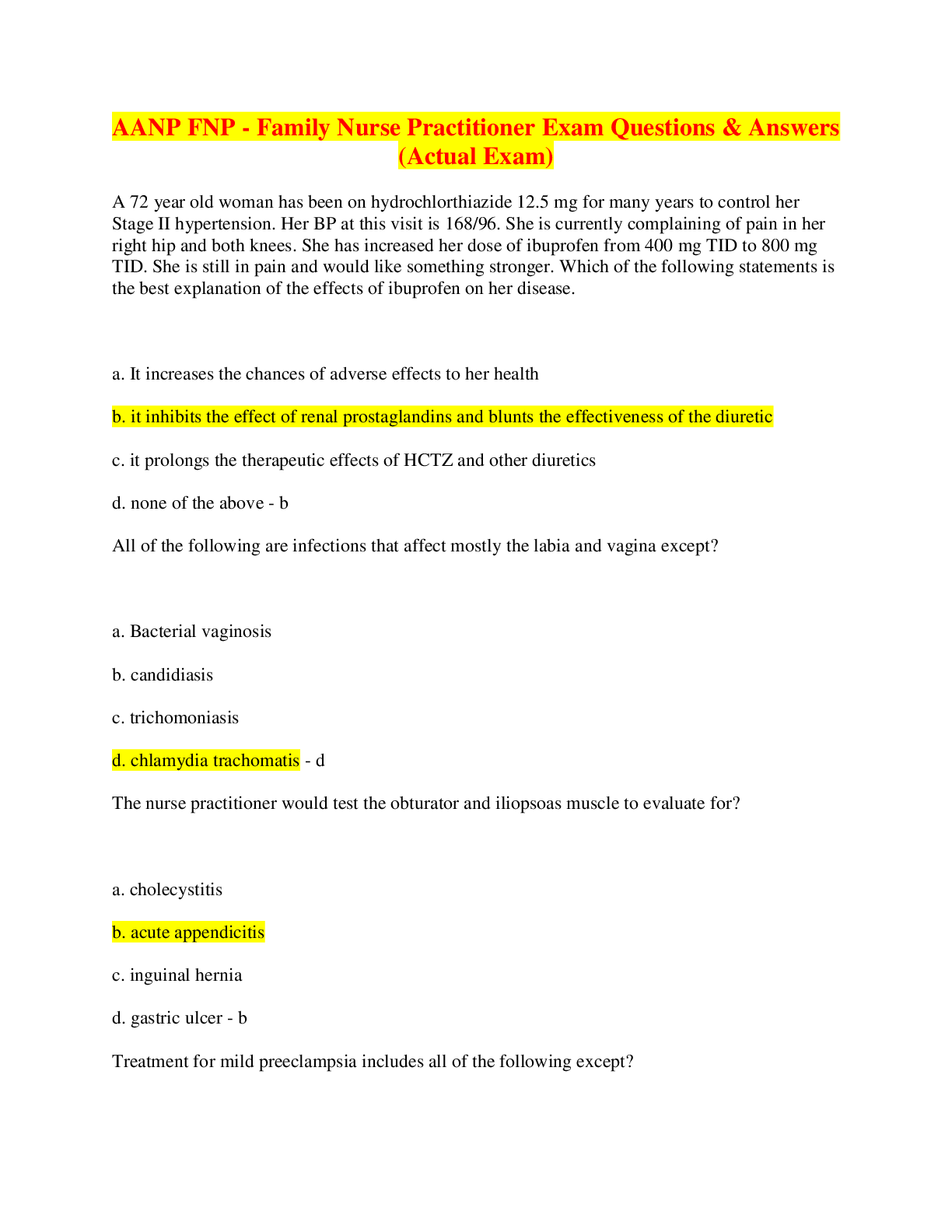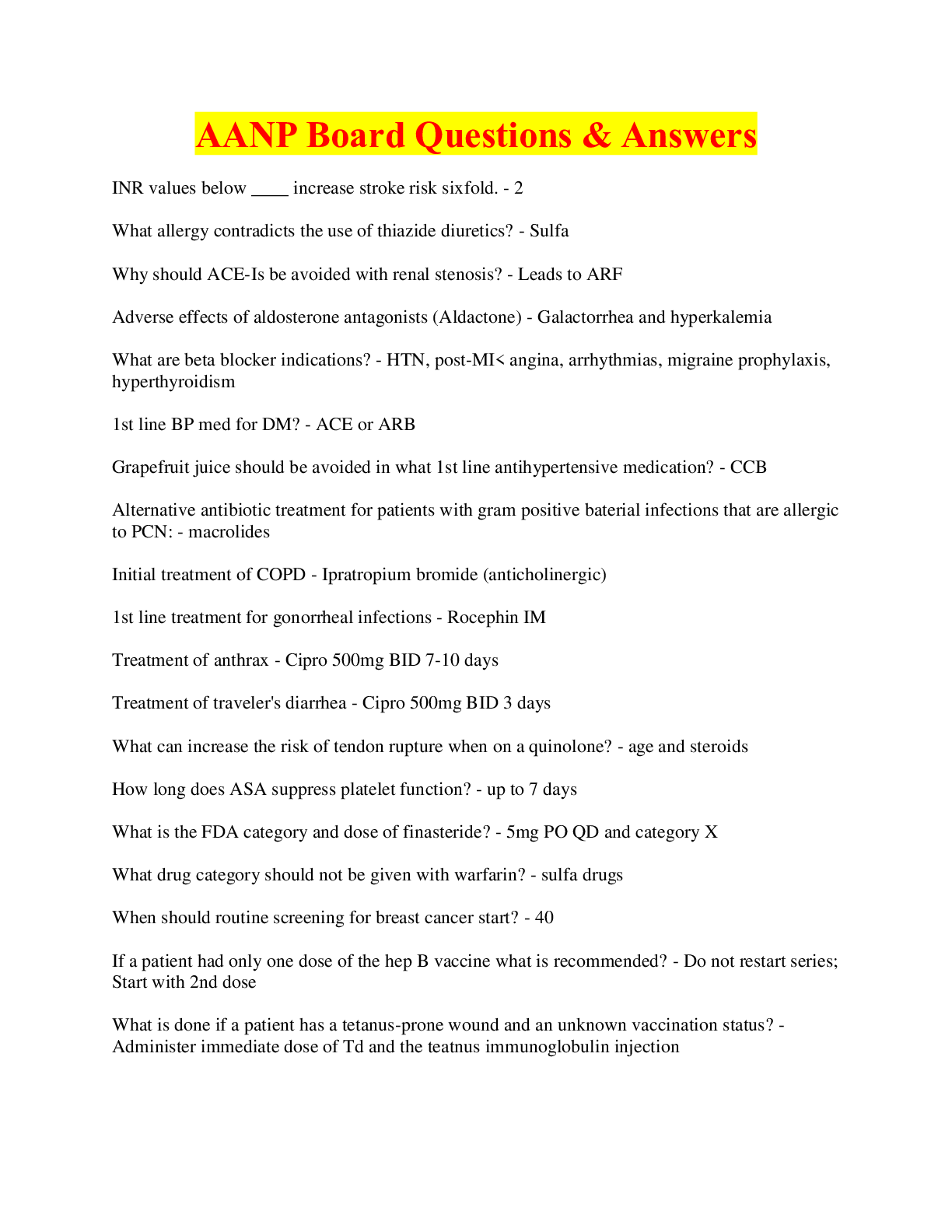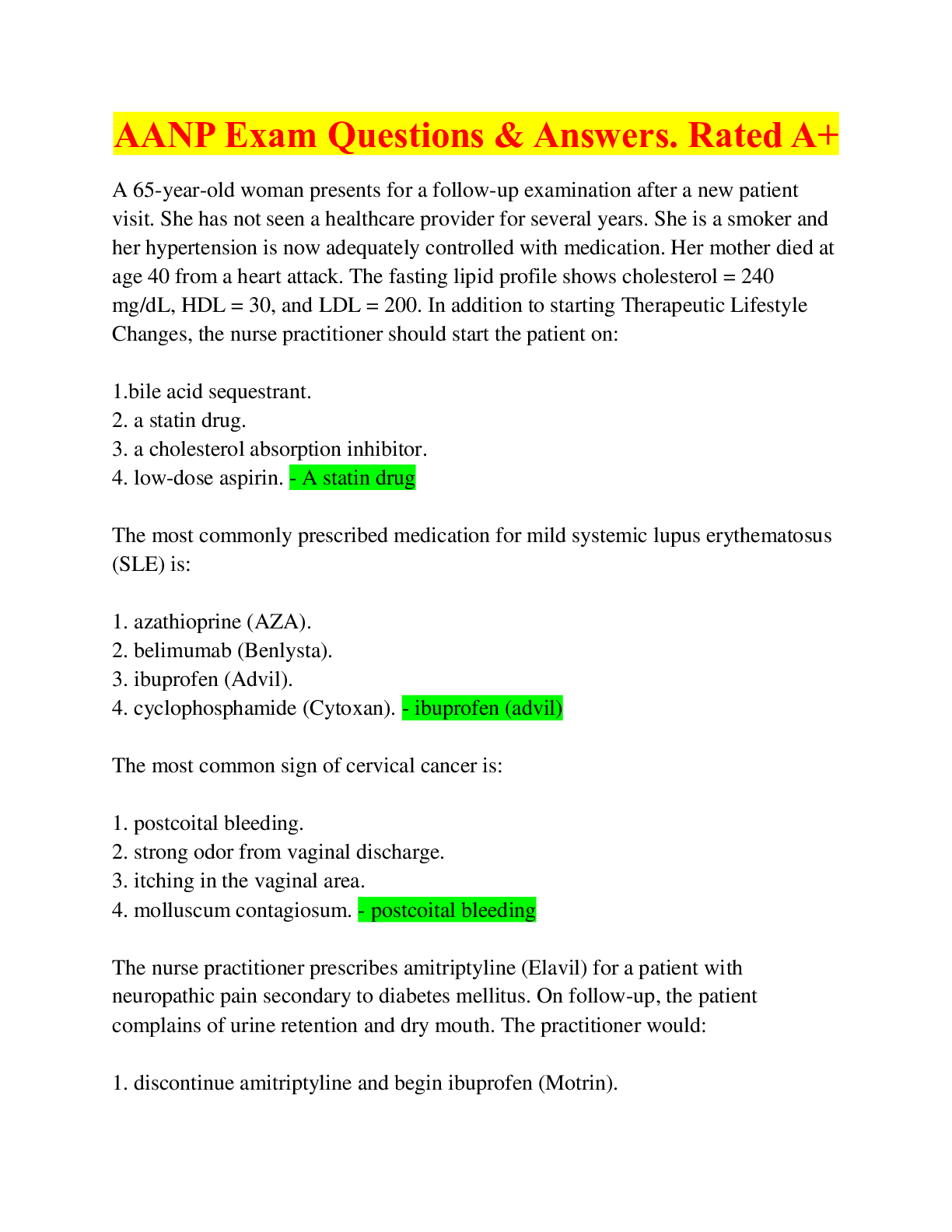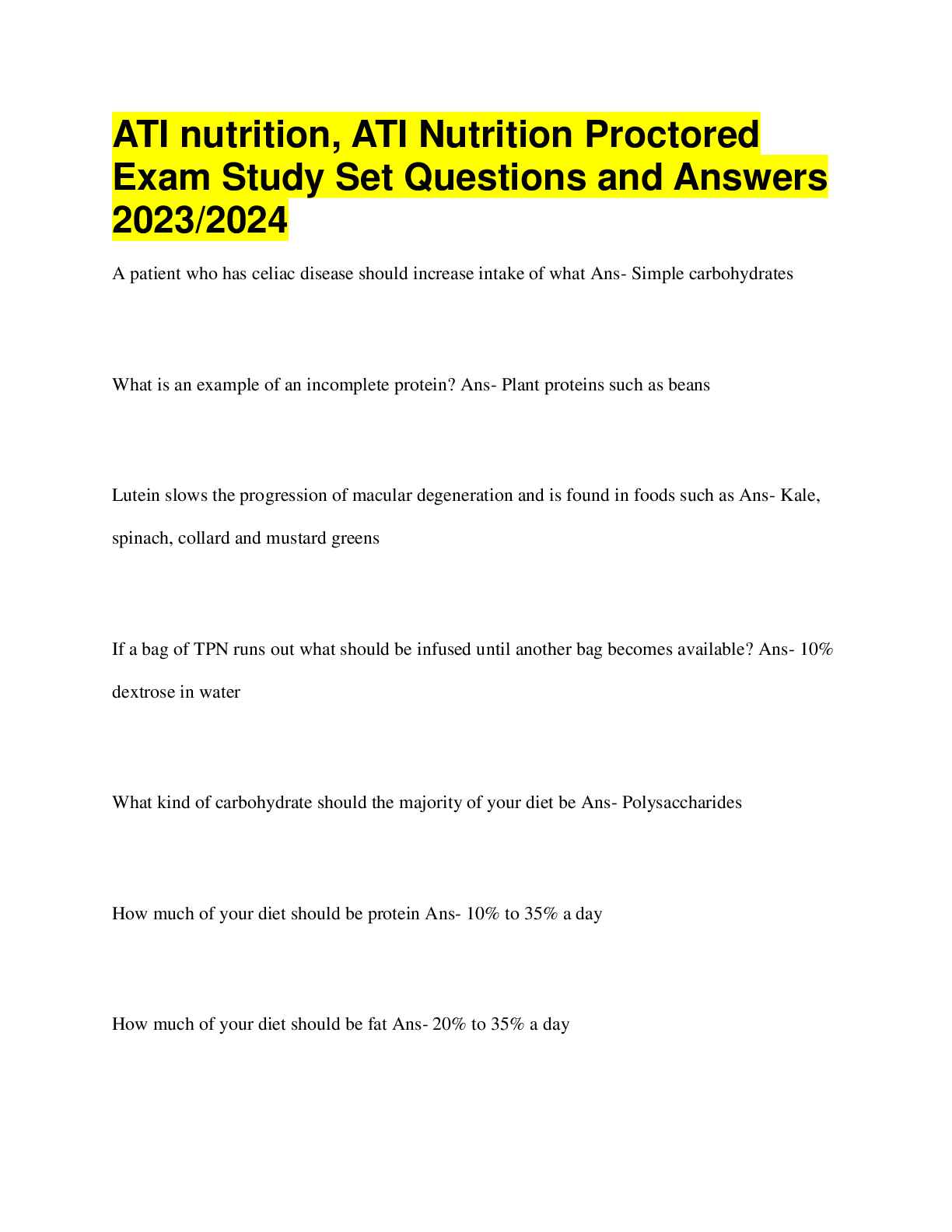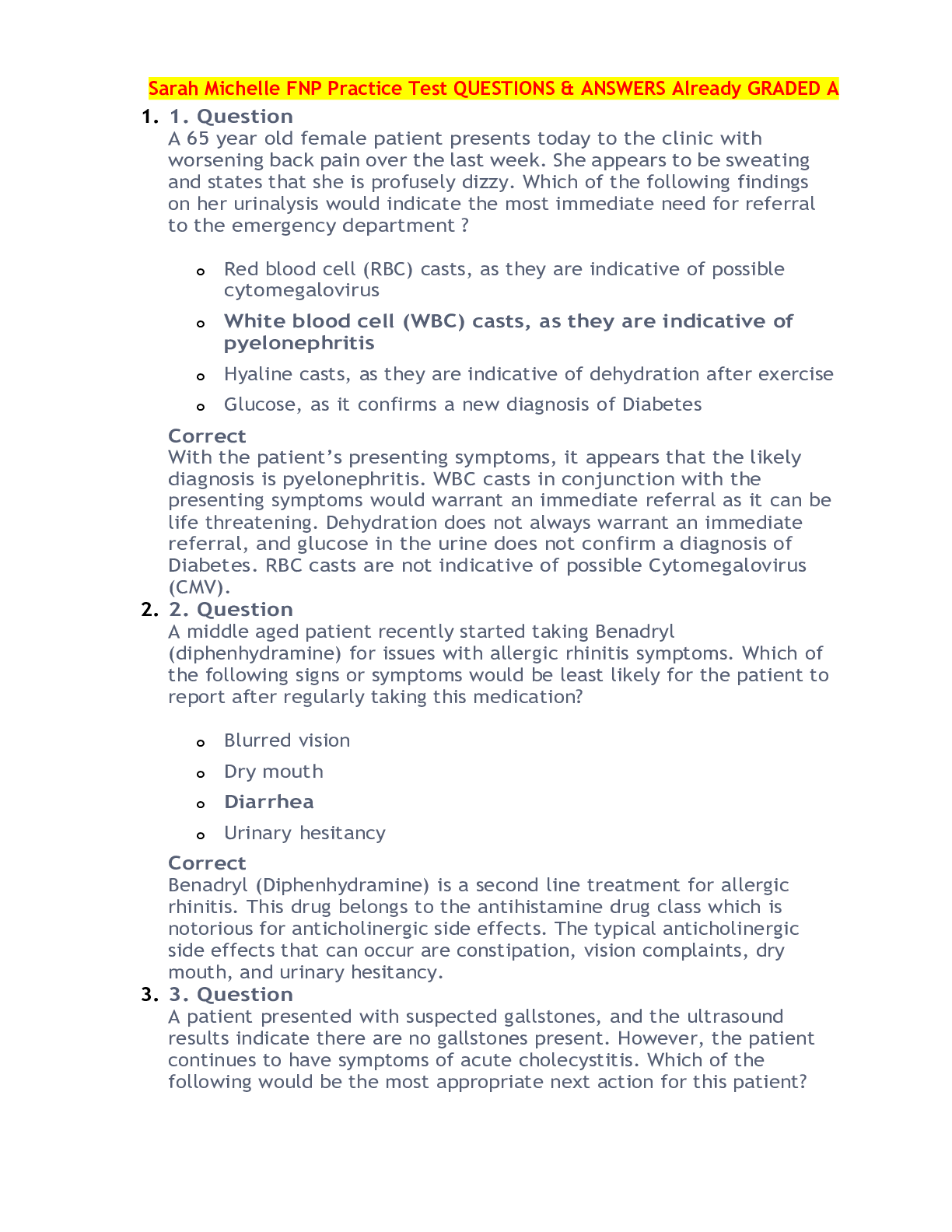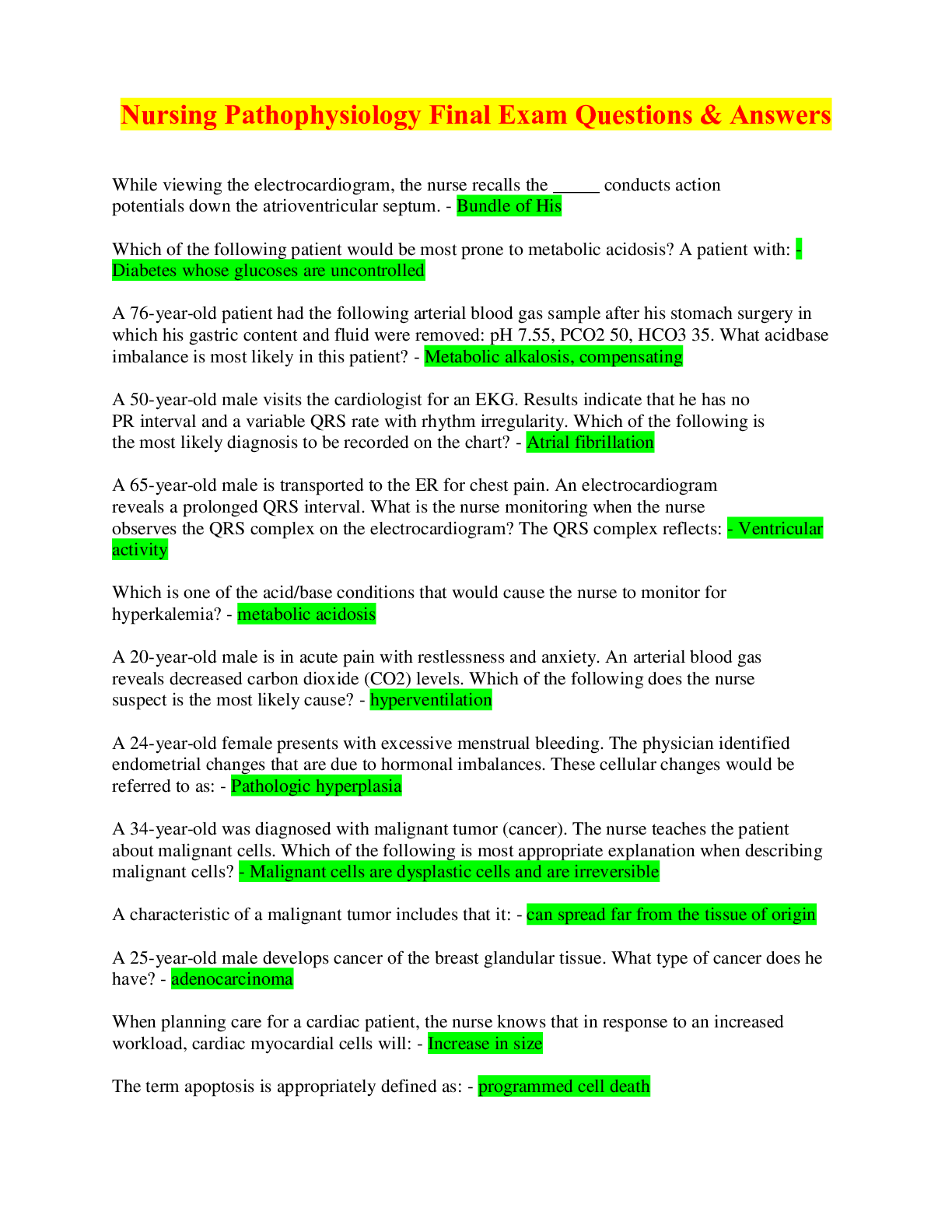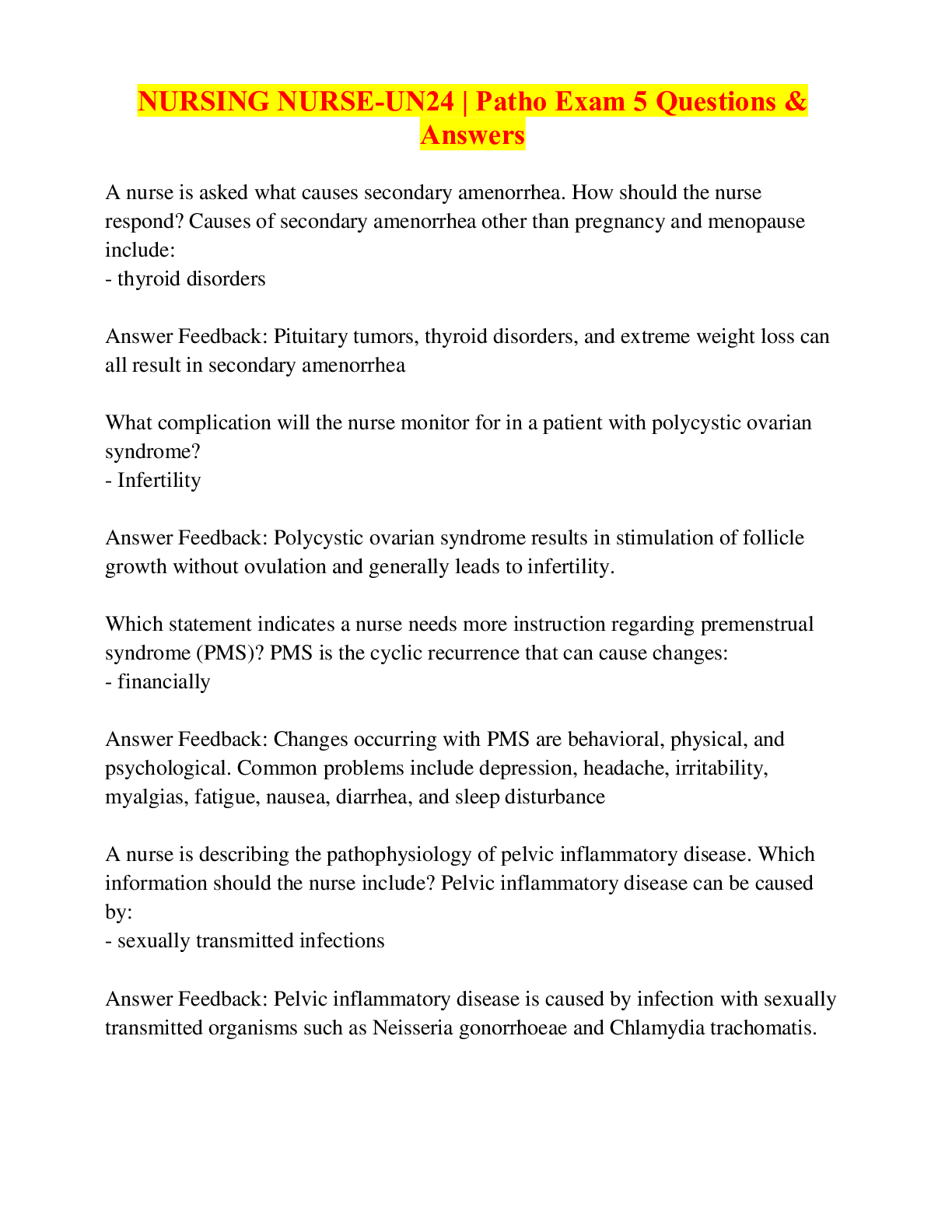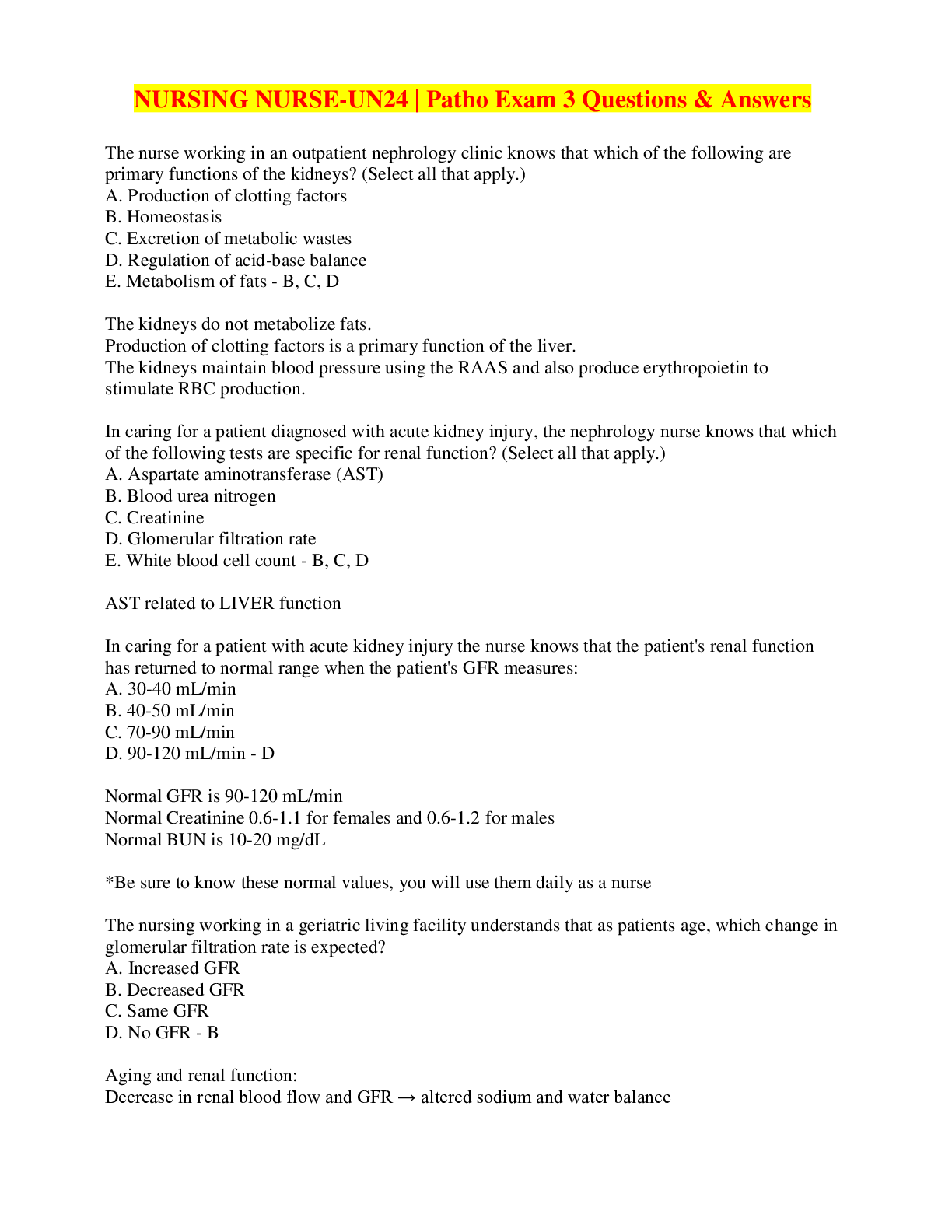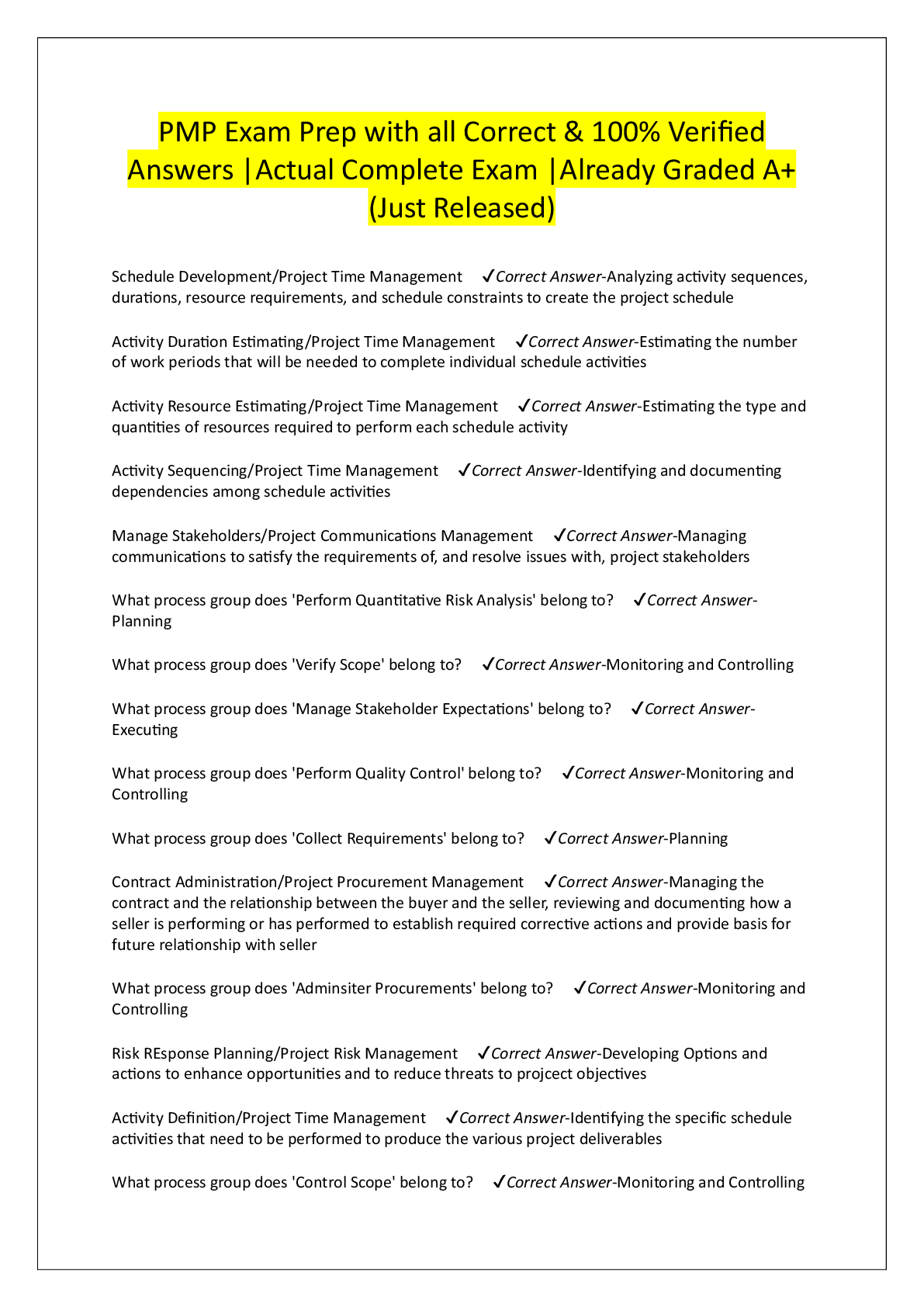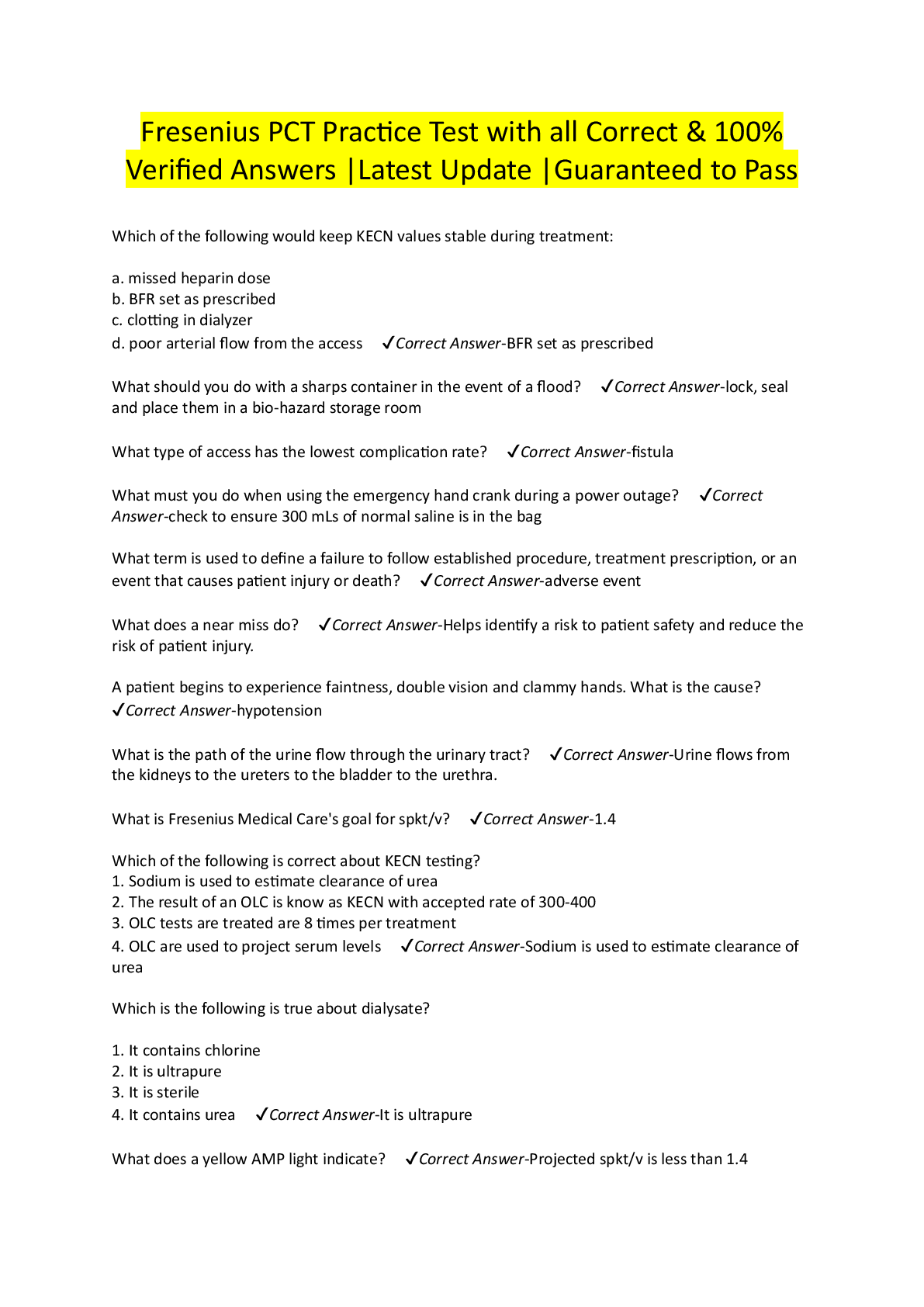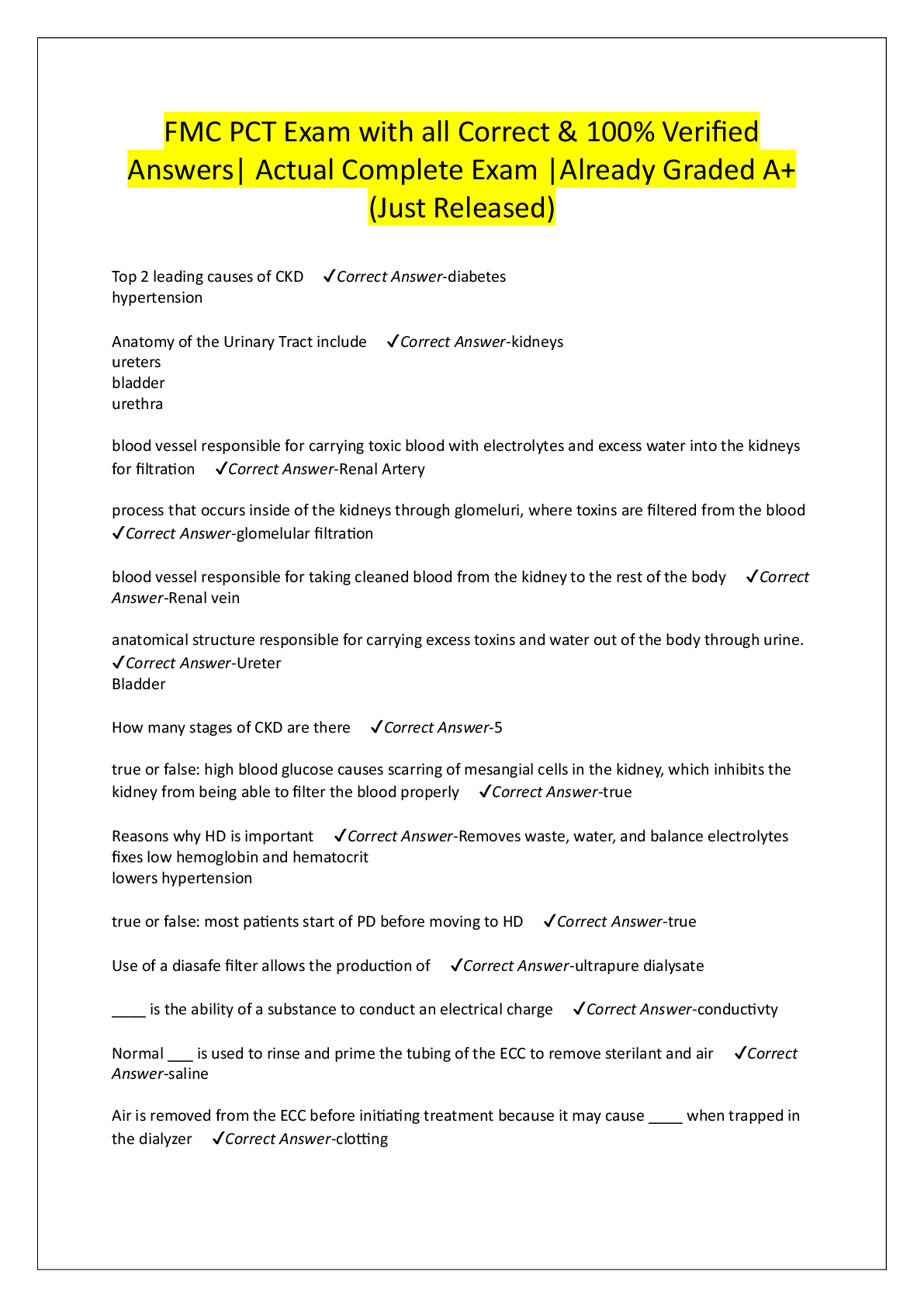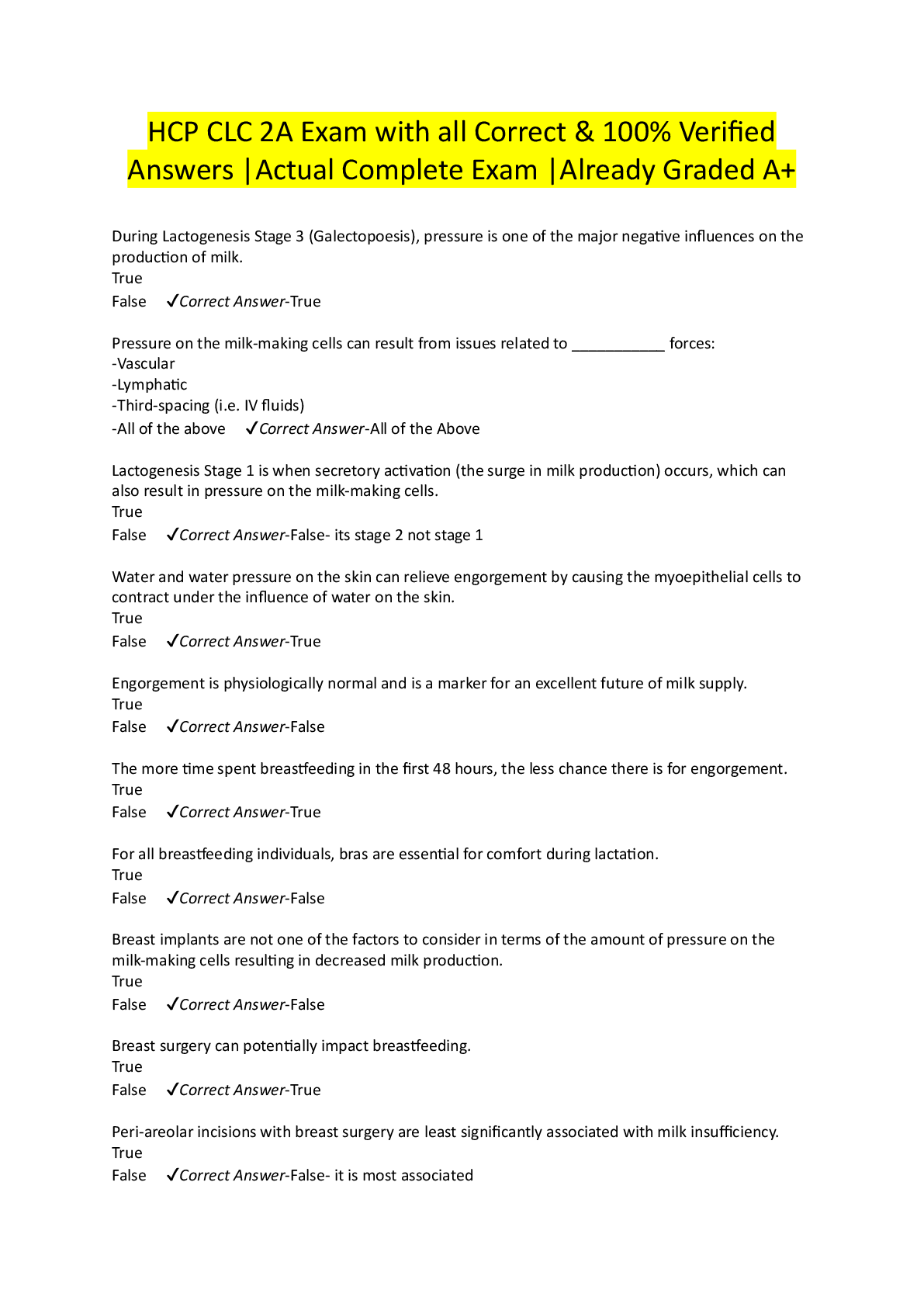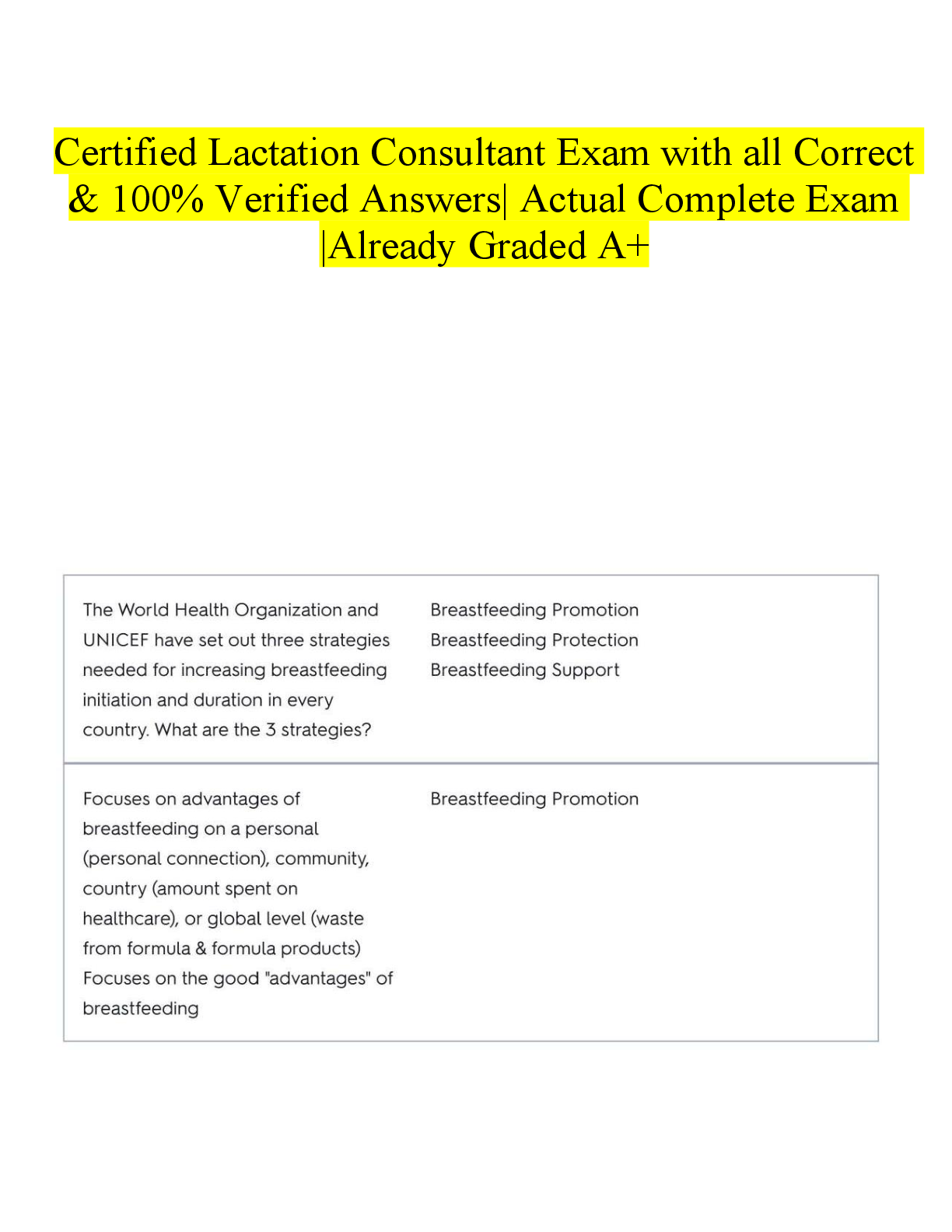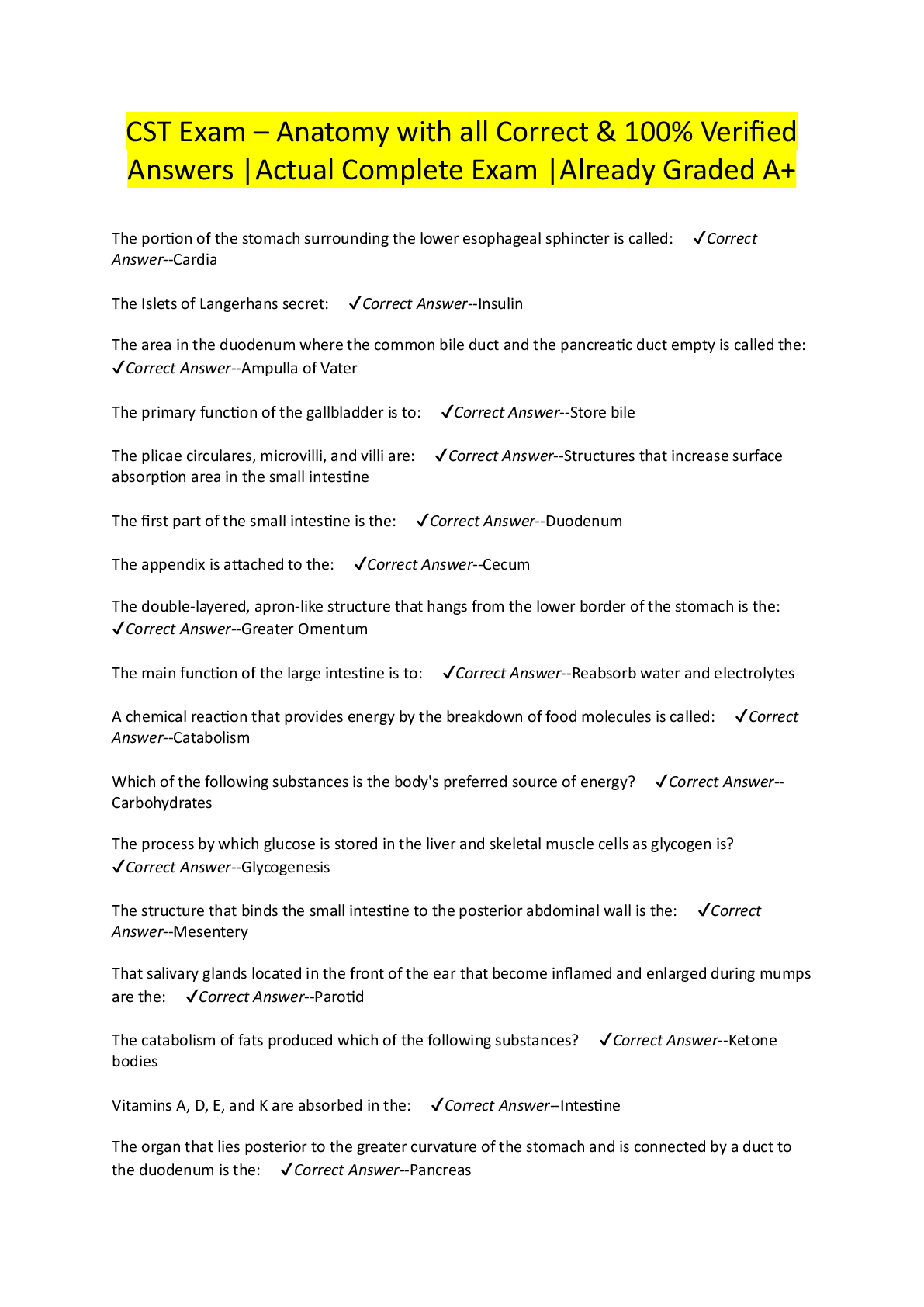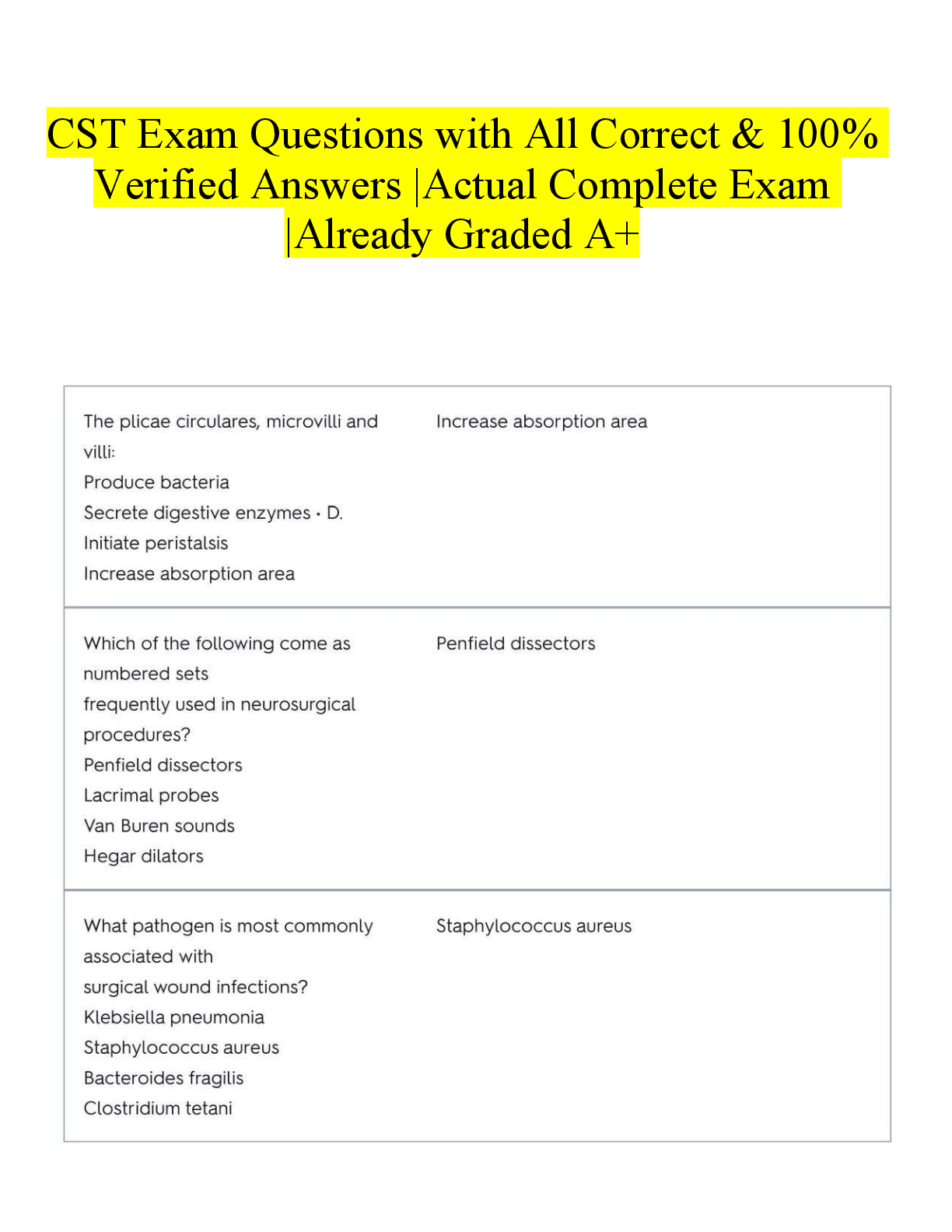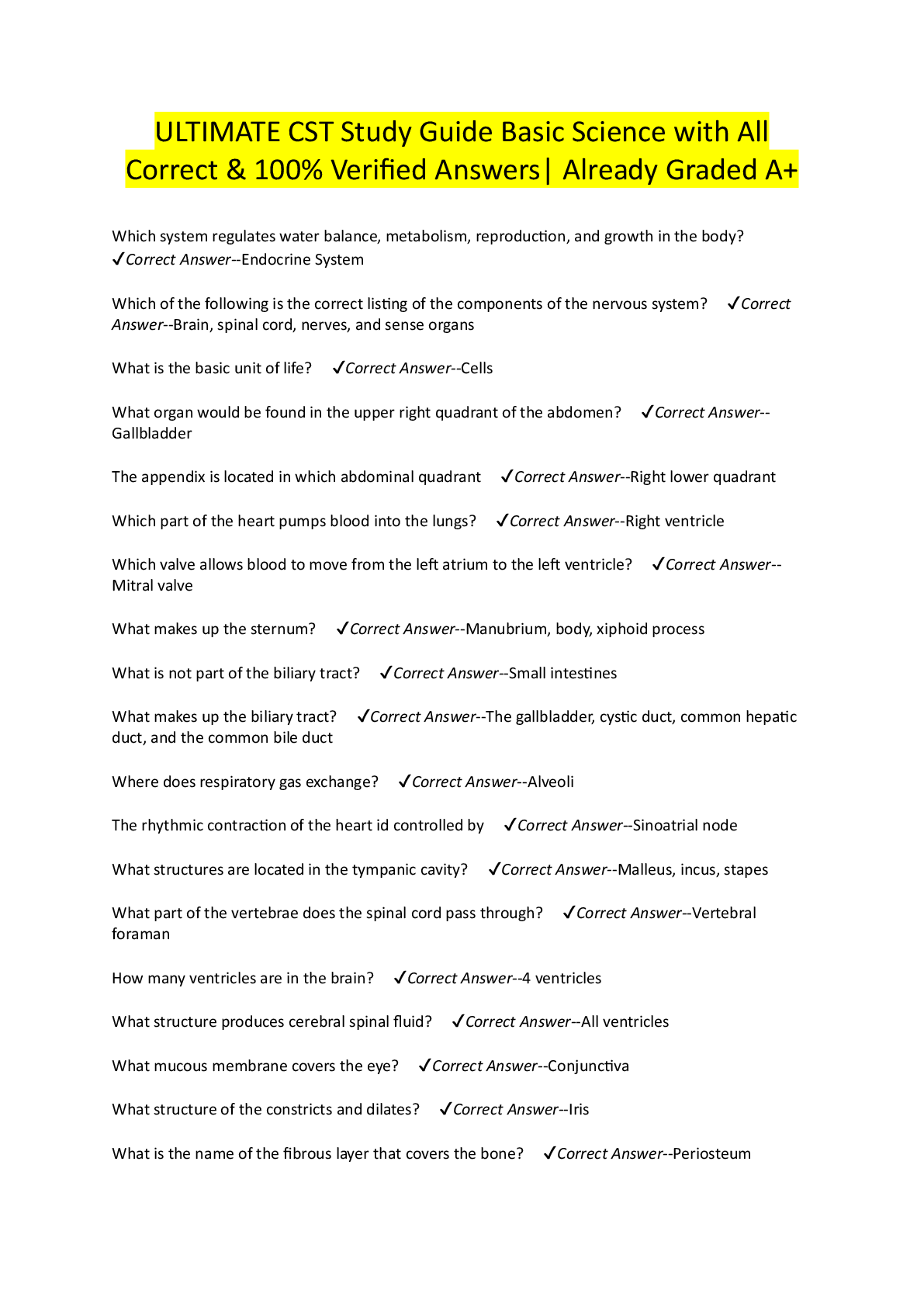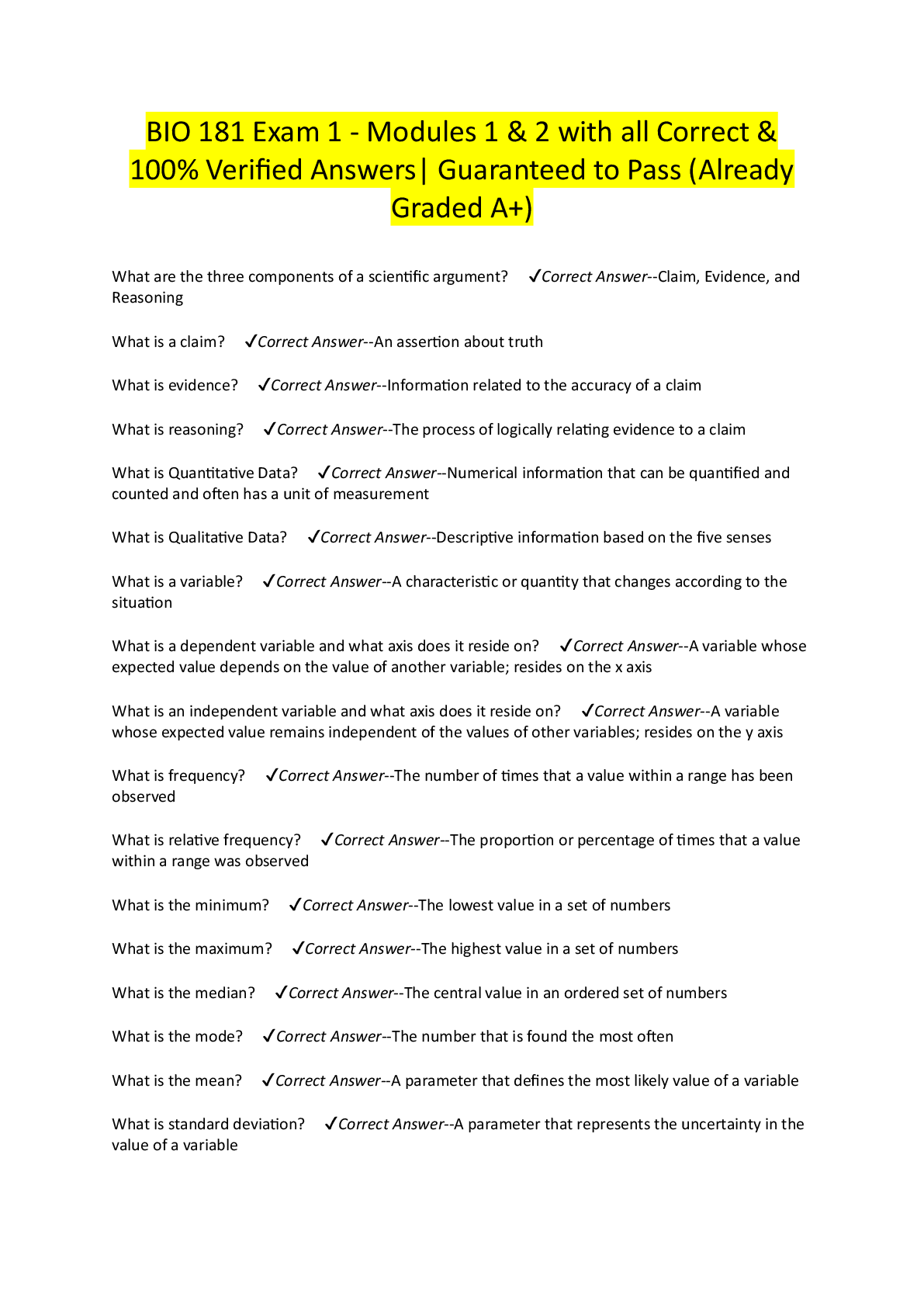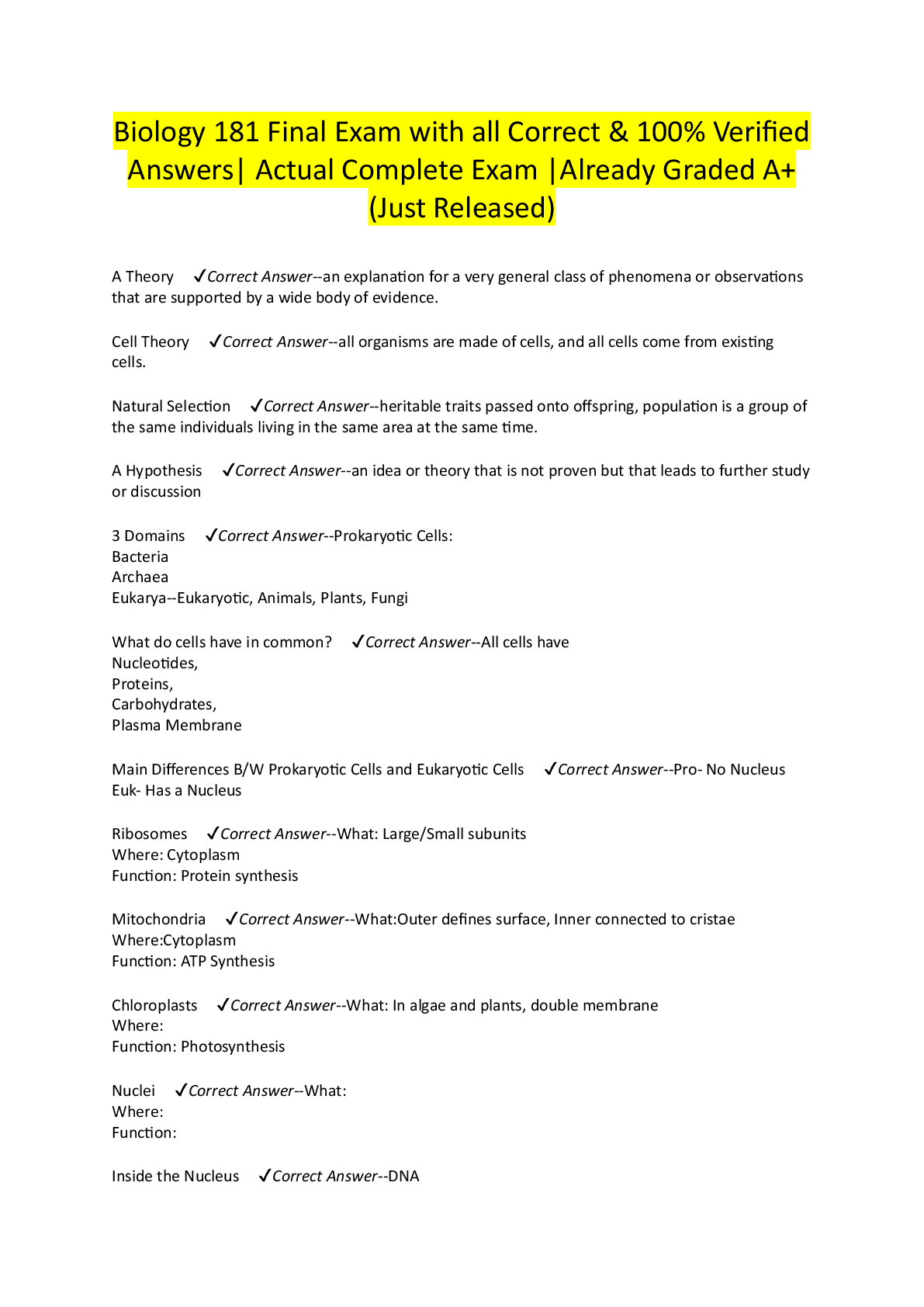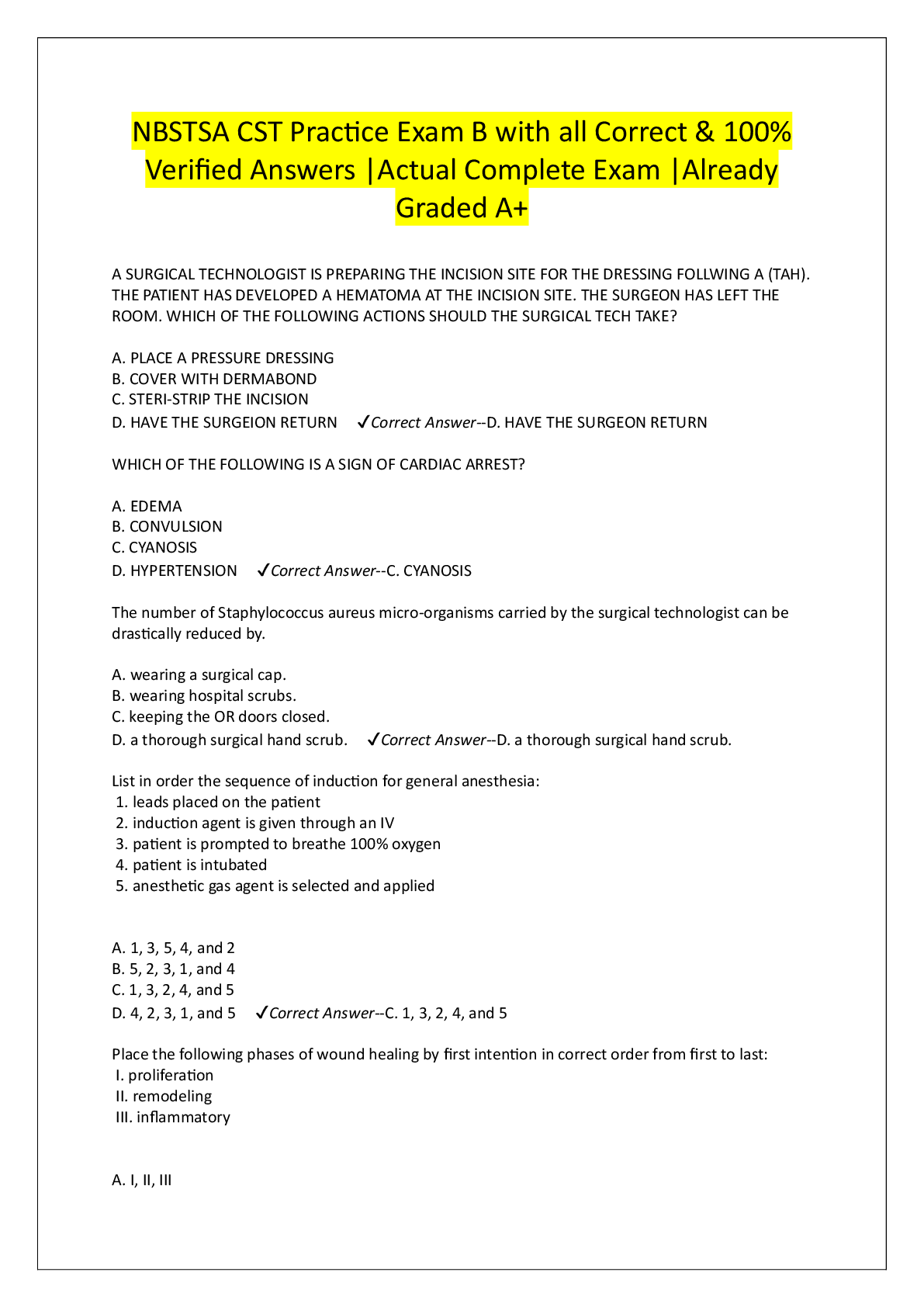NREMT® EMT, Answers Deeply Explained, latest Updated
Document Content and Description Below
NREMT® EMT, Answers Deeply Explained, latest Updated-Which of the following is an example of an unsafe scene for an EMT-Basic to enter? A. Fifty-four-year old male with difficulty breathing B. Tw ... enty-three-year old female with abdominal pain C. Eighteen-year old adolescent with a gunshot wound to the chest D. Four-year old child with leg pain - C. Eighteen-year old adolescent with a gunshot wound to the chest Reason: Any dispatch to a call with violence involved, such as a gunshot wound, must be secured by police prior to EMS involvement. The other calls do not give any inidication of being unsafe. The arterioles connect the _________ and the capillaries. A. Veins B. Venules C. Arteries D. Vena cavae - C. Arteries Reason: The path of blood flow goes from the heart to the aorta to the arteries to the arterioles to the capillaries to the venules to the veins to the vena cavae to the heart. Which of the following patients is at greatest risk for hypothermia? A. Thirty-year old firefighter B. Twelve-year old skier C. Forty-five year old EMT D. Seventy-year old librarian - D. Seventy-year old librarian Reason: The very young and very old are greater rsk for hypothermia The zygomatic bones are located in the A. Chest B. Lower leg C. Back D. Face - D. Face Reason: The zygomatic bones are the cheekbones Which of the following federal laws was created to prevent "patients dumping" and the practice of denying treatment to patients with no insurance? A. Emergency Medical Treatment and Active Labor Act (EMTALA) B. The White Paper Act C. Health Insurance Portability and Accountability Act (HIPAA) D. The Medical Practice Act of 1988 - A. Emergency Medical Treatment and Active Labor Act (EMTALA) Reason: The EMTALA was enacted by Congress in 1986 to ensure public access to emergency services regardless of their ability to pay. This act was also created to prevent hospitals from dumping their patients on other hospitals because of the patient's financial status. The White Paper (A) was not an act, but was a paper published in 1966 addressing the inadequacy of pre-hospital emergency medical care. The Health Insurance Portability and Accountability Act (HIPAA) (C) was created to protect the provacy of healthcare information. There is no such act as the Medical Practice Act of 1988 (D). When using air transport, the EMT-Basic should approach a helicopter A. From the uphill side B. From the rear C. Only when instructed by a helicopter crew member D. Under no circumstances, but instead allow the crew to come to them - C. Only when instructed by a helicopter crew member Reason: Helicopters are dangerous vechicles, and safety rules include never approaching from the uphill side because of the danger of the rotors, or from the rear because of the tail rotor. In addition, EMT-Basics should never approach until instructed by a helicopter crew member so that the patient loading can be coordinated safely. Not approaching the helicopter at all may be impractical due to patient care concerns. Which of the following should be noted as insignificant in conducting the patient assessment? A. Medication bottles B. Comments of bystanders and family members C. Physical condition of the patient D. Patient's medical insurance - D. Patient's medical insurance Reason: (A), (B), and (C) are all significant in conducting patient assessment. A patient's medical insurance is not a consideration in treating emergency patients. Which of the following is NOT a component of the Glasgow Coma Scale? A. Eye opening B. Verbal response C. Motor response D. Tactile sensatory response - D. Tactile sensatory response Reason: (A), (B), and (C) are all components of the Glasgow Coma Scale You have an EMT student riding with you one day. The student is studying for an upcoming test and cannot remember a legal term. The student knows that you must have four elements in order to prove this type of claim. The student knows that the four elements are duty, breach of duty, proximate cause, and harm caused. What term is the EMT student studying? A. Abandonment B. Simple negligence C. Gross negligence D. Malpractice - B. Simple negligence Reason: In order to prove simple (also called ordinary) negligence, there must be four elements; duty, breach of duty, proximate cause, and harm caused The head is _________ to the chest. A. Inferior B. Anterior C. Superior D. Posterior - C. Superior Reason: Superior refers to an upper region, so the head is considered superior to the chest, while the chest would be considered inferior to the head. Anterior is the front, and posterior is the back What does the "A" stand for in DCAP-BTLS A. Anascoria B. Arterial bleeding C. Alert response D. Abrasions - D. Abrasions Reason: The "A" in DCAP-BTLS stands for abrasions There are ________ vertebrae in the lumbar section A. 5 B. 12 C. 14 D. 19 - A. 5 Reason: The cervical section of the spine has 7 vertebrae, the thoracic 12, the lumber 5, the sacral 5, and the coccyx 4 Signs and symptoms of post-traumatic stress disorder (PTSD) include the following EXCEPT [Show More]
Last updated: 11 months ago
Preview 1 out of 47 pages

Buy this document to get the full access instantly
Instant Download Access after purchase
Buy NowInstant download
We Accept:

Also available in bundle (1)
Click Below to Access Bundle(s)
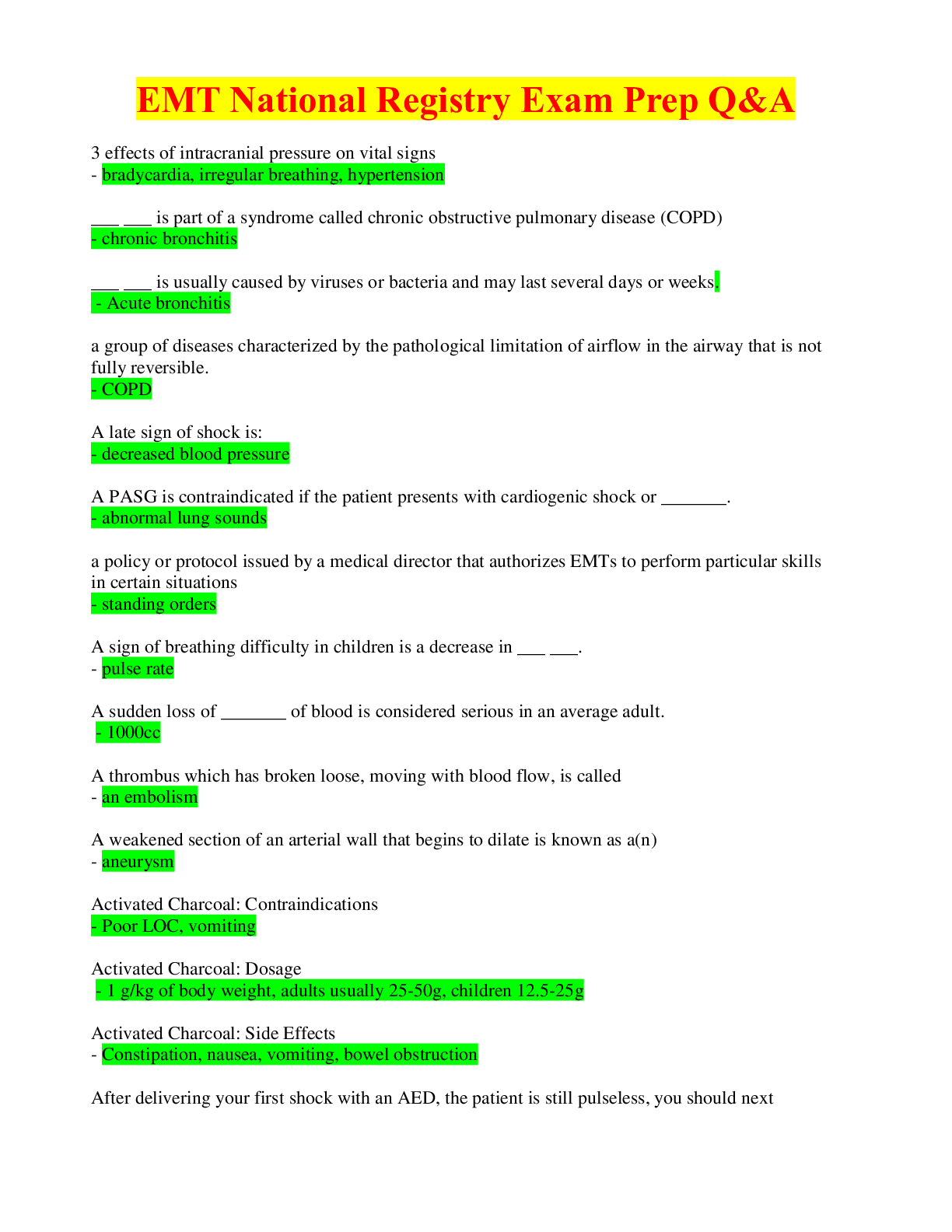
EMT/NREMT | National Registry of Emergency Medical Technicians: Emergency Medical Responder Bundles, ( From 2019 to 2022) Updated Answers A+ Guide!
EMT/NREMT | National Registry of Emergency Medical Technicians: Emergency Medical Responder Bundles, ( From 2019 to 2022) Updated Answers A+ Guide!
By PROF 3 years ago
$50.5
10
Reviews( 0 )
$14.50
Can't find what you want? Try our AI powered Search
Document information
Connected school, study & course
About the document
Uploaded On
May 15, 2022
Number of pages
47
Written in
All
Additional information
This document has been written for:
Uploaded
May 15, 2022
Downloads
0
Views
234

